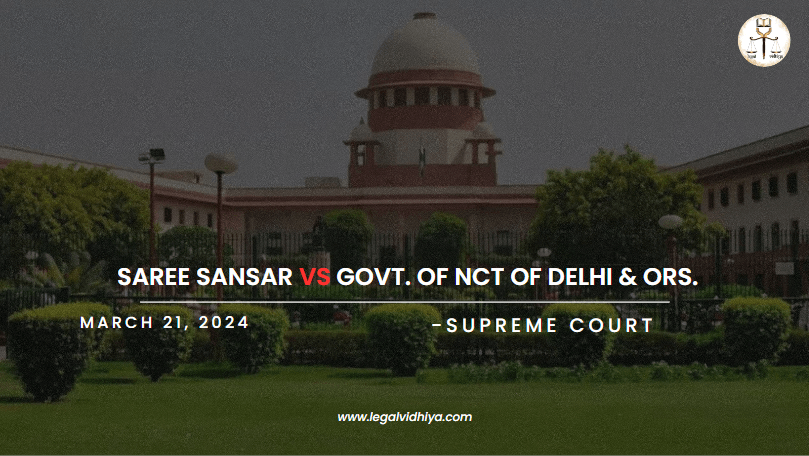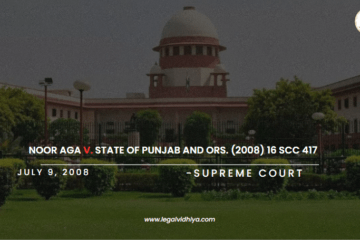
| CITATION | 2024 0 CJ(SC) 145 |
| DATE OF JUDGMENT | March 21, 2024 |
| COURT | Supreme Court of India |
| APPELLANT | Saree Sansar |
| RESPONDENT | Gov. Of NTC of Delhi & ors. |
| BENCH | Abhay S. Oka, Sanjay Karol |
| STATUES REFERRED | DST Act Additional Duties Excise (Goods of special importance) Act, 1957Article 266 and Article 269 of Constitution of India CST Act ( Central Sales Tax) – Section 15(1) |
INTRODUCTION AND FACTS
The legal dispute between Saree Sansar and the Government of NTC of Delhi and Ors revolves around the imposition of state sales tax on silk fabric. Initially set at 3% on March 31, 1999, the tax rate was later increased to 12% when silk fabric was added to Schedule I of the DST Act on January 15, 2000. Subsequently, on March 31, 2000, silk fabric was moved from Schedule I to Schedule II of the DST Act, resulting in a tax rate of 4%. Despite this, an assessment order was issued on October 31, 2001, demanding payment of state sales tax at the 12% rate for the period between January 15, 2000, and March 31, 2000, totaling Rs.4,22,095/-. Saree Sansar challenged this order by filing a writ petition in the Delhi High Court, which was ultimately dismissed in the judgment.
ISSUES RAISED
- The question which was raised is, was it justified for the government of NTC of Delhi to enforce a 12% state sales tax on silk fabric despite it being amended to 4%?
- The issue is, was the high Court decision appropriate, or did it contain errors?
CONTENTIONS OF APPEALENT
- The counsel representing the appellant contended that “Silk Sarees” are classified as declared goods according to the Additional Duties of Excise (Goods of Special Importance) Act, 1957. Consequently, the Delhi Government lacks the authority to levy state sales tax on these goods.
- They explained that according to the ADE Act, additional responsibilities are imposed on declared goods instead of sales tax, and the resulting funds are allocated among states based on a specified percentage after deducting a portion for Union Territories.
- Reference was made to Articles 266 and 269 of the Constitution of India, which outline the collection and distribution of tax revenue.
- The counsel cited court cases to support the argument that no state can levy sales tax if they are receiving proceeds under the ADE Act.
- The council emphasized that the ADE Act is designed to promote consistency in taxation for essential goods throughout the nation.
- Furthermore, the counsel contended that the deletion of “silk fabric” from the Central Sales Tax Act is irrelevant to the case.
- They suggested that under Section 15(1) of the CST Act, the Government of Delhi cannot impose sales tax exceeding 4%, making the imposition of a 12% tax rate unlawful.
- Overall, the counsel asserted that the Delhi Government’s levy of sales tax on “Silk Sarees” was not permissible under the ADE Act and exceeded the legally allowable tax rate, making it invalid.
CONTENTIONS OF RESPONDENT
- The counsel for the respondents argued that silk fabric was removed from the list of items subject to sales tax above 4% from May 11, 1968.
- Therefore, the government of Delhi was not able to collect any additional duty on silk fabric as it was not covered under the Additional Duty of Excise Act.
- The counsel maintained that the Delhi High Court’s decision was correct and should not be challenge.
SUPREME COURT OVERVIEW
- During the period from January 15, 2000, to March 31, 2000, the focus of the appeal lies on the imposition of a 12% sales tax on silk fabric under the DST Act. The removal of Sections 14 and 15 of the Central Sales Tax Act by Act No. 18 of 2017 had previously classified certain goods as crucial for inter-state trade. Silk sarees were initially part of this category until May 11, 1968, when they were excluded by Act No. 19 of 1968. These legislative alterations have a direct impact on the current taxation of silk fabric within the specified timeframe.
- Section 15(1) of the CST Act previously limited the local sales tax rate for declared goods to 4%. However, when silk fabric was no longer classified as a declared good on May 11, 1968, there was no longer a restriction on imposing sales tax on silk fabric above 4%. Therefore, the appellant’s argument based on Section 15(1) of the CST Act does not apply to the disputed assessment, as it was conducted under conditions where sales tax could exceed 4% for goods not listed under Section 14.
- The appellant’s argument is rooted in the Second Schedule of the ADE Act, which delineates the percentage of net proceeds of additional duties that must be allocated to each state. While silk sarees are categorized in Schedule I of the ADE Act with no duty to be paid, the appellant contends that duty should be imposed in accordance with the Second Schedule of the ADE Act. This schedule specifies that a specific percentage of the net proceeds of additional duties should be distributed to each state, after subtracting an amount allocated to Union territories. Furthermore, the provision stipulates that if a state imposes a tax on the sale or purchase of goods listed in the First Schedule of the ADE Act, then no payments shall be made to that state unless directed otherwise by the Central Government. This argument serves as the foundation of the appellant’s position regarding the duty owed on silk sarees under the ADE Act.
JUDGEMENT
The Apex court has declared that the second Schedule of the ADE Act specifies that each State will receive a certain percentage of net proceeds from additional duties collected during the financial year for specific goods. Although silk fabric is not subject to additional duty under the ADE Act, states are still allowed to impose sales tax. If States choose to impose sales tax, they will not receive any portion of the additional duty. Therefore, the assertion that including silk fabric in Schedule I of the ADE Act prevents the State Government from imposing sales tax is incorrect and baseless.
The High Court recognized the validity of a notification issued under the DST Act in a previous case, and the Delhi High Court’s decision in that case was upheld by the Court in a judgment in May 2023. The ruling in the Godfrey Phillips India Ltd. v. State of UP case is not relevant to the current issue under discussion.
The Delhi High Court view upheld, appeal dismissed with no costs ordered.
ANALYSIS
The claim that the inclusion of silk fabric in Schedule I of the ADE Act prevents the State Government from imposing sales tax is unfounded .
During the relevant period, Section 15(1) of the CST Act imposed a restriction on the maximum local sales tax rate applicable to declared goods, ensuring it did not surpass 4%. As silk fabric falls within the category of declared goods as per Section 14, the DST Act stipulated that the sales tax rate on silk fabric should also not exceed 4%.
The imposition of the ADE Act did not result in an extra obligation on silk fabric, which led to the states receiving compensation for the loss of revenue. Throughout the relevant timeframe, silk fabric was not included in the list specified in Section 14, which allowed for the imposition of sales tax at a rate higher than 4%. A comprehensive scheme was introduced to replace the diverse sales tax rates imposed by different states on specific goods, and in return, the states were compensated with a portion of the proceeds through additional excise duties.
The CST Act underwent amendments in 1957 and 1958, which included the addition of excise duty on specific goods and the declaration of certain goods, thereby affecting the imposition of sales tax on silk fabric. The modifications in the sequence of goods as per the 1944 Act and their consequential impact on the 1957 Act were duly recorded. In 2017, Sections 14 and 15 of the CST Act were removed, indicating the dynamic nature of tax laws.
The case between State of Kerala and Attesee involved the correlation between the CST Act, ADE Act, and State Sales Tax Act. Article clause (2) starting from 11-9-1956 empowers Parliament to establish guidelines for identifying sale or purchase of goods in particular cases. An amendment was made to clause (3) to limit State authority in levying sales or purchase tax on declared goods.
Consequently, this led to the conclusion that there were no errors in the judgment of the high Court, thus prompting the supreme Court to dismiss the appeal without any cost orders.
CONCLUSION
Silk fabric was not included in Section 14 of the CST Act during the applicable timeframe, which meant that sales tax exceeding 4% could not be imposed on it, this was a significant benefit for the silk fabric industry, as it ensured that the tax burden on their products remained relatively low.
Furthermore, it was discovered that the absence of a duty payable on silk fabric under the ADE Act did not prevent the State from imposing sales tax. This meant that even though there was no duty imposed on silk fabric, the State still had the authority to impose sales tax on it. This allowed the State to generate revenue from the sale of silk fabric without any hindrance.
Overall, the exclusion of silk fabric from Section 14 of the CST Act and the absence of duty payable on it under the ADE Act had a significant impact on the silk fabric industry. It ensured that the sales tax on silk fabric remained within a reasonable limit, while still allowing the State to collect revenue. This favorable treatment contributed to the growth and success of the silk fabric industry during the relevant period.
REFERENCES
- https://www.advocatekhoj.com/library/judgments/announcement.php?WID=17402
- https://newslaw.in/case-type/civil/state-of-delhi-v-silk-fabric-appellant/
This Article is written by Princy Lohani, student of Kalinga University, Raipur, 8st Sem B.A. LL.B ; Intern at Legal Vidhiya
Disclaimer: The materials provided herein are intended solely for informational purposes. Accessing or using the site or the materials does not establish an attorney-client relationship. The information presented on this site is not to be construed as legal or professional advice, and it should not be relied upon for such purposes or used as a substitute for advice from a licensed attorney in your state. Additionally, the viewpoint presented by the author is of a personal nature.




0 Comments